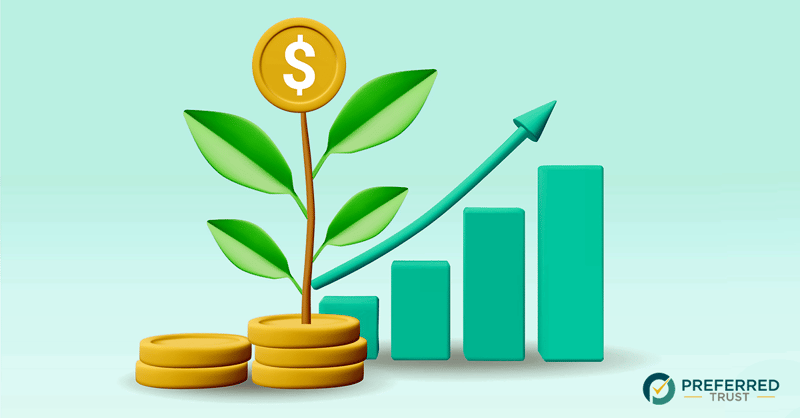Understanding Capital Gains on Retirement Accounts: What Every Investor Should Know
Planning for retirement isn’t just about saving; it’s also about managing your investments and taxes wisely. Often overlooked is understanding capital gains on retirement accounts. Whether you have a Traditional IRA, Roth IRA, or an employer-sponsored plan, knowing how capital gains are handled can help you keep more of your investment growth for the future.
In this blog, we explain how IRA distributions, capital gains in an IRA account, and Roth IRA withdrawals impact your retirement strategy.

IRA Distribution: How Withdrawals Affect Capital Gains and Taxes
When you take an IRA distribution, the tax impact depends entirely on the type of account you have.
For Traditional IRAs, contributions come from pre-tax dollars. You delay taxes during the growth phase of your retirement investment but pay them later when you withdraw. All distributions are taxed as ordinary income, including any growth from capital gains.
For Example:
 Mark, age 65, invested $100,000 in a Traditional IRA that grew to $250,000. When he withdraws $50,000, the IRS treats the entire amount as taxable income. It does not matter if $40,000 came from capital gains; it is all considered ordinary income.
Mark, age 65, invested $100,000 in a Traditional IRA that grew to $250,000. When he withdraws $50,000, the IRS treats the entire amount as taxable income. It does not matter if $40,000 came from capital gains; it is all considered ordinary income.
For Roth IRA distributions, contributions come from after-tax dollars, meaning you have already paid taxes on your investment upfront. If your account is at least five years old, and you are 59½ or older, your Roth IRA distributions are completely tax-free (including all investment gains).
Both Traditional and Roth IRAs allow tax-deferred growth, but only Roth IRAs provide tax-free withdrawals in retirement.
Capital Gains in an IRA Account: The Silent Engine of Growth
Many investors think that they have to pay capital gains taxes when selling investments in an IRA account. In truth, all trading activity in your IRA is tax-sheltered.
Here’s what that means:
 You can buy and sell stocks, bonds, or mutual funds without triggering a taxable event.
You can buy and sell stocks, bonds, or mutual funds without triggering a taxable event.
 There’s no need to track short-term and long-term capital gains.
There’s no need to track short-term and long-term capital gains.
 You only pay taxes when you withdraw from a Traditional IRA, or not at all if it’s a qualified Roth withdrawal.
You only pay taxes when you withdraw from a Traditional IRA, or not at all if it’s a qualified Roth withdrawal.
Let’s consider this scenario:
 Lisa invests $10,000 in a stock fund within her IRA and another $10,000 in a taxable brokerage account. Both earn 8% annually. After 25 years, her IRA grows to about $68,000 tax-deferred, while the taxable account is around $55,000 due to annual capital gains taxes.
Lisa invests $10,000 in a stock fund within her IRA and another $10,000 in a taxable brokerage account. Both earn 8% annually. After 25 years, her IRA grows to about $68,000 tax-deferred, while the taxable account is around $55,000 due to annual capital gains taxes.
That’s the advantage of letting gains grow without interruption. It’s a hidden benefit of retirement accounts that can greatly improve long-term results.
Do You Pay Capital Gains on a Roth IRA? The Advantage of Tax-Free Growth
One common question from investors is: Do you pay capital gains on a Roth IRA?
The answer is no if your withdrawal is qualified.
Since Roth IRAs are funded with after-tax contributions, all future earnings, including capital gains, interest, and dividends, grow tax-free. Once you meet the five-year rule and reach age 59½, you can withdraw every dollar without paying extra taxes.
For Example:

David, age 62, invested $50,000 in a Roth IRA eight years ago. The account is now worth $100,000. When he withdraws the full balance, both the original contributions and the $50,000 in capital gains are completely tax-free.
However, early withdrawals before meeting those conditions (five-year rule and reaching the age of 59½) can lead to taxes and penalties on the earnings portion.
This tax-free treatment makes Roth IRAs particularly appealing for younger investors or those who expect higher tax rates in retirement.
Smart Strategies to Manage Capital Gains on Retirement Accounts
Here are some practical strategies to help make the most of your capital gains on retirement accounts:
- Diversify your account types by maintaining both a Traditional and a Roth IRA. This will help to balance your future tax exposure.
- Plan your withdrawals. Coordinate IRA distributions with your income to avoid higher tax brackets.
- Consider Roth conversions. Convert portions of a Traditional IRA into a Roth IRA during low-income years for future tax-free growth.
- Leverage tax deferral. Keep high-turnover investments inside your IRA to protect them from capital gains.
- Work with professionals. Consult a tax or financial advisor to create a personalized retirement income strategy that works for your personal situation.
Each of these strategies can help reduce the impact of taxes and keep more of your portfolio’s growth working for you.
Final Thoughts: Turning Capital Gains into Long-Term Retirement Growth
Whether you’re handling IRA distributions, tracking capital gains in an IRA account, or making sure your Roth IRA stays tax-free, these rules can influence your financial security in retirement.
When managed wisely, retirement accounts not only shield your investments from immediate taxes but also help your wealth grow faster through compounding. The less you pay in taxes, the more you retain.
Continue Your Financial Education with Preferred Trust
At Preferred Trust, we believe that informed investors make better financial decisions. Check out more educational articles, industry insights, and investor resources on our Ignite Funding Blog to stay ahead in today’s changing investment landscape.
To open an account with Preferred Trust Company, get started here.



